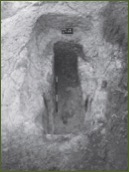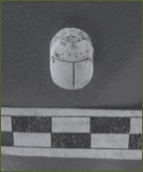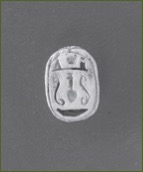Tomb no. 248
Tomb 248 is part of the Phoenician necropolis. It is one of the oldest, most interesting tombs in the Monte Sirai settlement. It can be dated between 600 and 570 B.C.


Figs. 1-2 - Aerial view of the Phoenician necropolis (photo UNICITY S.p.A.); map of the necropolis and location of tomb 248 (GUIRGUIS 2013, fig. 28).
The tomb is a large rectangular pit, where the dead person was buried lying down, covered by three large stone slabs.
Several Phoenician ceramic items were placed around the body, both created on the wheel and by hand (jugs with mushroom edge, plates, a transportation amphora and mixing pots). A Phoenician scarab in soapstone, made in the Egyptian centre of Naucratis no later than 570 B.C. can be noted.
These ceramics, their arrangement and the Naucratis scarab are confirmation that the tomb was of a person of a high social class.



Figs. 3-5 - Tomb 248 during dig and the Naucratite production scarab (GUIRGUIS 2008, figs. 2; 5-6).
Bibliografia
- M. GUIRGUIS, Nuovi dati dalla necropoli fenicia e punica di Monte Sirai (Sardegna): la tomba 248, in L’Africa romana XVII (Sevilla 2006), Roma 2008, pp. 1633-1652.
- M. GUIRGUIS, Monte Sirai 1963-2013 mezzo secolo di indagini archeologiche, Sassari.

 VR
VR